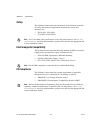
Appendix B Troubleshooting
© National Instruments Corporation B-3 NI 17xx Smart Camera User Manual
NI 17xx Smart Camera for information about installing software on
the smart camera or contact National Instruments for assistance.
• In the event that the Direct Drive lighting controller detects an
abnormal load condition, such as a short circuit on the LED+ output,
the smart camera stops image acquisition and returns an error. The
Direct Drive stops providing current to the light, and the smart camera
may restart. Ensure that your lighting wire connections are correct
and/or reconfigure your lighting settings in MAX or Vision Builder AI.
• The voltage drop of the light may have exceeded the maximum voltage
or minimum voltage requirements of the smart camera. The voltage
drop of a light can vary significantly with environmental conditions,
such as temperature, current, and strobe time. Verify that the voltage
drop across the LED+ and LED– terminals is within the specified
range of the smart camera. Your light may need to be reconfigured by
the manufacturer to bring the voltage drop within the specified range
of the smart camera. Refer to Appendix A, Specifications, for more
information.
• The smart camera ran out of memory. The reason may be that acquired
images are still in memory. When developing applications with
LabVIEW, use the IMAQ Dispose VI to destroy an image and free the
space it occupied in memory. This VI is required for each image
created in an application to free the memory allocated to the IMAQ
Create VI. Execute the IMAQ Dispose VI only when the image is no
longer needed in your application. You can configure the IMAQ
Dispose VI to free memory for each call to the IMAQ Create VI or just
once for all images created using the IMAQ Create VI.
Run-Time Problems
The NI Smart Camera is Unresponsive and Blinks the IMG ACQ and
FAIL LEDs
The smart camera maximum internal temperature was exceeded. Complete
the following steps to verify that the ambient and enclosure temperatures
are within specifications.
1. Measure the ambient temperature and verify that it is within
specifications.
Note If the smart camera is mounted within an enclosure, the ambient temperature of the
camera is the temperature inside the enclosure, which can be notably warmer than the
ambient temperature outside the enclosure.


















